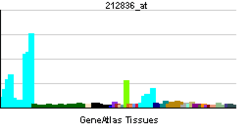POLD3
| View/Edit Human | View/Edit Mouse |
DNA polymerase delta subunit 3 is an enzyme that in humans is encoded by the POLD3 gene.[4][5] It is a component of the DNA polymerase delta complex.
Interactions
POLD3 has been shown to interact with PCNA.[6][7]
References
- ↑ "Diseases that are genetically associated with POLD3 view/edit references on wikidata".
- ↑ "Human PubMed Reference:".
- ↑ "Mouse PubMed Reference:".
- ↑ Hughes P, Tratner I, Ducoux M, Piard K, Baldacci G (Jun 1999). "Isolation and identification of the third subunit of mammalian DNA polymerase delta by PCNA-affinity chromatography of mouse FM3A cell extracts". Nucleic Acids Res. 27 (10): 2108–14. doi:10.1093/nar/27.10.2108. PMC 148430
 . PMID 10219083.
. PMID 10219083. - ↑ "Entrez Gene: POLD3 polymerase (DNA-directed), delta 3, accessory subunit".
- ↑ Ducoux M, Urbach S, Baldacci G, Hübscher U, Koundrioukoff S, Christensen J, Hughes P (Dec 2001). "Mediation of proliferating cell nuclear antigen (PCNA)-dependent DNA replication through a conserved p21(Cip1)-like PCNA-binding motif present in the third subunit of human DNA polymerase delta". J. Biol. Chem. 276 (52): 49258–66. doi:10.1074/jbc.M106990200. PMID 11595739.
- ↑ Ohta S, Shiomi Y, Sugimoto K, Obuse C, Tsurimoto T (Oct 2002). "A proteomics approach to identify proliferating cell nuclear antigen (PCNA)-binding proteins in human cell lysates. Identification of the human CHL12/RFCs2-5 complex as a novel PCNA-binding protein". J. Biol. Chem. 277 (43): 40362–7. doi:10.1074/jbc.M206194200. PMID 12171929.
Further reading
- Nomura N, Miyajima N, Sazuka T, Tanaka A, Kawarabayasi Y, Sato S, Nagase T, Seki N, Ishikawa K, Tabata S (1995). "Prediction of the coding sequences of unidentified human genes. I. The coding sequences of 40 new genes (KIAA0001-KIAA0040) deduced by analysis of randomly sampled cDNA clones from human immature myeloid cell line KG-1". DNA Res. 1 (1): 27–35. doi:10.1093/dnares/1.1.27. PMID 7584026.
- Zeng XR, Jiang Y, Zhang SJ, Hao H, Lee MY (1994). "DNA polymerase delta is involved in the cellular response to UV damage in human cells". J. Biol. Chem. 269 (19): 13748–51. PMID 7910606.
- Longley MJ, Pierce AJ, Modrich P (1997). "DNA polymerase delta is required for human mismatch repair in vitro". J. Biol. Chem. 272 (16): 10917–21. doi:10.1074/jbc.272.16.10917. PMID 9099749.
- Mo J, Liu L, Leon A, Mazloum N, Lee MY (2000). "Evidence that DNA polymerase delta isolated by immunoaffinity chromatography exhibits high-molecular weight characteristics and is associated with the KIAA0039 protein and RPA". Biochemistry. 39 (24): 7245–54. doi:10.1021/bi0000871. PMID 10852724.
- Ducoux M, Urbach S, Baldacci G, Hübscher U, Koundrioukoff S, Christensen J, Hughes P (2002). "Mediation of proliferating cell nuclear antigen (PCNA)-dependent DNA replication through a conserved p21(Cip1)-like PCNA-binding motif present in the third subunit of human DNA polymerase delta". J. Biol. Chem. 276 (52): 49258–66. doi:10.1074/jbc.M106990200. PMID 11595739.
- Ohta S, Shiomi Y, Sugimoto K, Obuse C, Tsurimoto T (2002). "A proteomics approach to identify proliferating cell nuclear antigen (PCNA)-binding proteins in human cell lysates. Identification of the human CHL12/RFCs2-5 complex as a novel PCNA-binding protein". J. Biol. Chem. 277 (43): 40362–7. doi:10.1074/jbc.M206194200. PMID 12171929.
- Pohler JR, Otterlei M, Warbrick E (2006). "An in vivo analysis of the localisation and interactions of human p66 DNA polymerase delta subunit". BMC Mol. Biol. 6: 17. doi:10.1186/1471-2199-6-17. PMC 1187890
 . PMID 16000169.
. PMID 16000169. - Takemura M, Yoshida S, Akiyama T, Kitagawa M, Yamada Y (2006). "Role of the second-largest subunit of DNA polymerase alpha in the interaction between the catalytic subunit and hyperphosphorylated retinoblastoma protein in late S phase". Biochim. Biophys. Acta. 1764 (9): 1447–53. doi:10.1016/j.bbapap.2006.06.015. PMID 16935576.
- Olsen JV, Blagoev B, Gnad F, Macek B, Kumar C, Mortensen P, Mann M (2006). "Global, in vivo, and site-specific phosphorylation dynamics in signaling networks". Cell. 127 (3): 635–48. doi:10.1016/j.cell.2006.09.026. PMID 17081983.
- Masuda Y, Suzuki M, Piao J, Gu Y, Tsurimoto T, Kamiya K (2007). "Dynamics of human replication factors in the elongation phase of DNA replication". Nucleic Acids Res. 35 (20): 6904–16. doi:10.1093/nar/gkm822. PMC 2175312
 . PMID 17932049.
. PMID 17932049.
This article is issued from Wikipedia - version of the 5/20/2016. The text is available under the Creative Commons Attribution/Share Alike but additional terms may apply for the media files.

